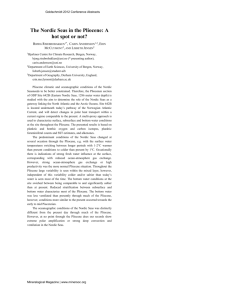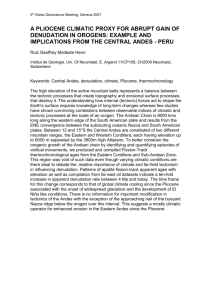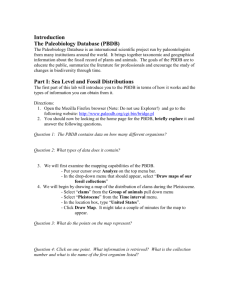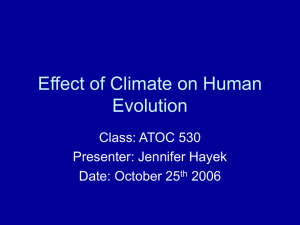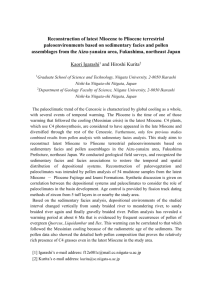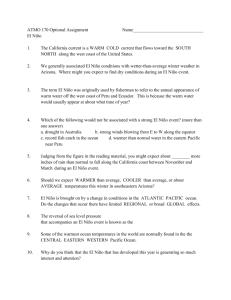Pliocene, El Niño and Northern / Southern Hemisphere Glaciation
advertisement
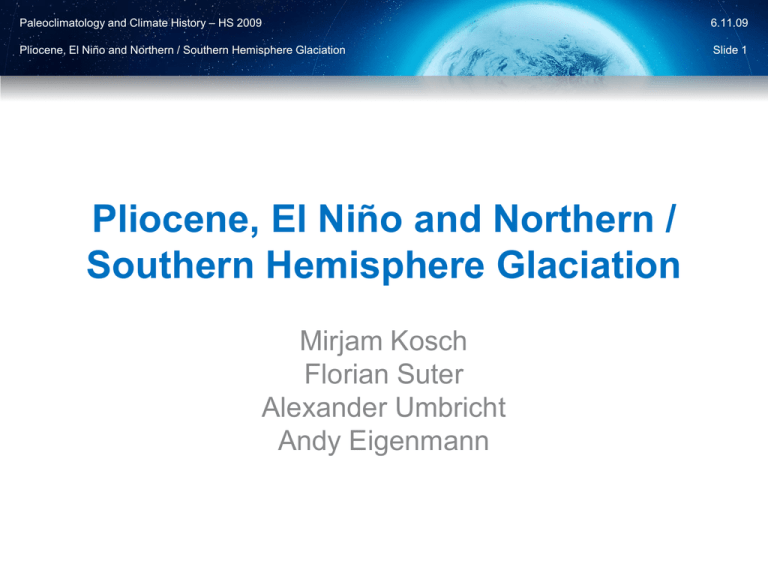
Paleoclimatology and Climate History – HS 2009 6.11.09 Pliocene, El Niño and Northern / Southern Hemisphere Glaciation Slide 1 Pliocene, El Niño and Northern / Southern Hemisphere Glaciation Mirjam Kosch Florian Suter Alexander Umbricht Andy Eigenmann Paleoclimatology and Climate History – HS 2009 6.11.09 Pliocene, El Niño and Northern / Southern Hemisphere Glaciation Slide 2 Questions Will the present warm conditions terminate soon, to be followed by the next ice age? Will the onset of the next ice age be inhibited by the current rise in the atmospheric concentration of GHG induced by humans? Will that rise restore the warm conditions of the early Pliocene? Paleoclimatology and Climate History – HS 2009 6.11.09 Pliocene, El Niño and Northern / Southern Hemisphere Glaciation Slide 3 Outline 1. Methods 2. Southern Hemisphere glaciation a. Opening of the Drake Passage 3. Northern Hemisphere glaciation a. Pliocene paradoxon b. Hypotheses for Greenland glaciation 4. Questions and Discussion Paleoclimatology and Climate History – HS 2009 6.11.09 Pliocene, El Niño and Northern / Southern Hemisphere Glaciation Slide 4 Paleoclimatology and Climate History – HS 2009 6.11.09 Pliocene, El Niño and Northern / Southern Hemisphere Glaciation Slide 5 1. Methods Paleoclimatology and Climate History – HS 2009 6.11.09 Pliocene, El Niño and Northern / Southern Hemisphere Glaciation Slide 6 d18O Terrestrial water enriched in light 16O Seawater enriched in heavier 18O Compare 18O/16O of sample with 18O/16O of standard (fossils) University of Vermont Paleoclimatology and Climate History – HS 2009 6.11.09 Pliocene, El Niño and Northern / Southern Hemisphere Glaciation Slide 7 Neodymium Isotopes eNd (143Nd/144Nd) Oceanic basins with distinct eNd -values Crusts and fossil fish teeth preserve eNd -values of bottom water Bassin connections Wikipedia, 2009 Paleoclimatology and Climate History – HS 2009 6.11.09 Pliocene, El Niño and Northern / Southern Hemisphere Glaciation Slide 8 Ice Rafted Debris (IRD) Objects deposited on/within ice shield (Debris) 2. Iceberg calves 3. Drifting and melting 4. Debris deposited onto bottom of the water body 1. Wikipedia, 2009 Paleoclimatology and Climate History – HS 2009 6.11.09 Pliocene, El Niño and Northern / Southern Hemisphere Glaciation Slide 9 2. Southern Hemisphere Glaciation Paleoclimatology and Climate History – HS 2009 Pliocene, El Niño and Northern / Southern Hemisphere Glaciation 6.11.09 Slide 10 Paleoclimatology and Climate History – HS 2009 6.11.09 Pliocene, El Niño and Northern / Southern Hemisphere Glaciation Slide 11 The Drake Passage Separation of South America and Antarctica Estimated opening: 49 – 17 Ma Enables Antarctic Circumpolar Current (ACC) Wikipedia, 2009 Eocene 55.8 – 33.9 Ma Oligocene 33.9 – 23 Ma Miocene 23 – 5.33 Ma Pliocene 5.33 – 2.59 Ma Paleoclimatology and Climate History – HS 2009 6.11.09 Pliocene, El Niño and Northern / Southern Hemisphere Glaciation Slide 12 The Drake Passage – Indications Tracking Pacific Seawater Neodymium ratio eNd Pacific eNd : -3 to -5 Atlantic eNd : approximately -9 Fossil fish teeth gained from sediments High resolution of benthic Nd signal Eocene 55.8 – 33.9 Ma Oligocene 33.9 – 23 Ma Miocene 23 – 5.33 Ma Pliocene 5.33 – 2.59 Ma Paleoclimatology and Climate History – HS 2009 6.11.09 Pliocene, El Niño and Northern / Southern Hemisphere Glaciation Eocene 55.8 – 33.9 Ma Oligocene 33.9 – 23 Ma Slide 13 Miocene 23 – 5.33 Ma Pliocene 5.33 – 2.59 Ma Paleoclimatology and Climate History – HS 2009 6.11.09 Pliocene, El Niño and Northern / Southern Hemisphere Glaciation Eocene 55.8 – 33.9 Ma Oligocene 33.9 – 23 Ma Slide 14 Miocene 23 – 5.33 Ma Pliocene 5.33 – 2.59 Ma Paleoclimatology and Climate History – HS 2009 6.11.09 Pliocene, El Niño and Northern / Southern Hemisphere Glaciation Eocene 55.8 – 33.9 Ma Oligocene 33.9 – 23 Ma Slide 15 Miocene 23 – 5.33 Ma Pliocene 5.33 – 2.59 Ma Paleoclimatology and Climate History – HS 2009 6.11.09 Pliocene, El Niño and Northern / Southern Hemisphere Glaciation Eocene 55.8 – 33.9 Ma Oligocene 33.9 – 23 Ma Slide 16 Miocene 23 – 5.33 Ma Pliocene 5.33 – 2.59 Ma Paleoclimatology and Climate History – HS 2009 6.11.09 Pliocene, El Niño and Northern / Southern Hemisphere Glaciation Slide 17 The Drake Passage – other possible Influences Weathering In general not high enough Exception: volcanic ash Eocene 55.8 – 33.9 Ma Oligocene 33.9 – 23 Ma Miocene 23 – 5.33 Ma Pliocene 5.33 – 2.59 Ma Paleoclimatology and Climate History – HS 2009 6.11.09 Pliocene, El Niño and Northern / Southern Hemisphere Glaciation Slide 18 The Drake Passage – other possible Influences Scotia Sea Eocene 55.8 – 33.9 Ma Oligocene 33.9 – 23 Ma Miocene 23 – 5.33 Ma Pliocene 5.33 – 2.59 Ma Paleoclimatology and Climate History – HS 2009 6.11.09 Pliocene, El Niño and Northern / Southern Hemisphere Glaciation Slide 19 The Drake Passage – other possible Influences Weathering In general not high enough Exception: volcanic ashes Water influx from the Indian Ocean Water influx from the Panama Seaway Eocene 55.8 – 33.9 Ma Oligocene 33.9 – 23 Ma Miocene 23 – 5.33 Ma Pliocene 5.33 – 2.59 Ma Paleoclimatology and Climate History – HS 2009 6.11.09 Pliocene, El Niño and Northern / Southern Hemisphere Glaciation Slide 20 The Drake Passage – other possible Influences Eocene 55.8 – 33.9 Ma Oligocene 33.9 – 23 Ma Miocene 23 – 5.33 Ma Pliocene 5.33 – 2.59 Ma Paleoclimatology and Climate History – HS 2009 6.11.09 Pliocene, El Niño and Northern / Southern Hemisphere Glaciation Slide 21 The Drake Passage – other possible Influences Weather In general not high enough Exception: volcanic ashes Water influx from the Indian Ocean Water influx from the Panama Seaway Eocene 55.8 – 33.9 Ma Oligocene 33.9 – 23 Ma Miocene 23 – 5.33 Ma Pliocene 5.33 – 2.59 Ma Paleoclimatology and Climate History – HS 2009 6.11.09 Pliocene, El Niño and Northern / Southern Hemisphere Glaciation Eocene 55.8 – 33.9 Ma Oligocene 33.9 – 23 Ma Slide 22 Miocene 23 – 5.33 Ma Pliocene 5.33 – 2.59 Ma Paleoclimatology and Climate History – HS 2009 6.11.09 Pliocene, El Niño and Northern / Southern Hemisphere Glaciation Slide 23 The Drake Passage – Feedbacks Enhancement of nutrition upwelling Stimulation of the biological pump Lowering of the atmospheric CO2-concentration Possible reduction of oceanic heat flux Eocene 55.8 – 33.9 Ma Oligocene 33.9 – 23 Ma Miocene 23 – 5.33 Ma Pliocene 5.33 – 2.59 Ma Paleoclimatology and Climate History – HS 2009 Pliocene, El Niño and Northern / Southern Hemisphere Glaciation 3. Northern Hemisphere Glaciation 6.11.09 Slide 24 Paleoclimatology and Climate History – HS 2009 Pliocene, El Niño and Northern / Southern Hemisphere Glaciation 6.11.09 Slide 25 Paleoclimatology and Climate History – HS 2009 6.11.09 Pliocene, El Niño and Northern / Southern Hemisphere Glaciation Slide 26 Pliocene Paradox Early Pliocene (5-3 Ma) showed a very different climate state even though the external forcings were practically the same as today. Eocene 55.8 – 33.9 Ma Oligocene 33.9 – 23 Ma Miocene 23 – 5.33 Ma Pliocene 5.33 – 2.59 Ma Paleoclimatology and Climate History – HS 2009 6.11.09 Pliocene, El Niño and Northern / Southern Hemisphere Glaciation Slide 27 Climate in early Pliocene (5-3 Ma) Similarities with today’s climate: Intensity of sunlight incident on Earth Global geography Atmospheric concentration of CO2 Eocene 55.8 – 33.9 Ma Oligocene 33.9 – 23 Ma Differences with today’s climate Higher globally averaged temperatures No continental glaciers on Northern Hemisphere Sea level 25 m higher Permanent El Niño Miocene 23 – 5.33 Ma Pliocene 5.33 – 2.59 Ma Paleoclimatology and Climate History – HS 2009 6.11.09 Pliocene, El Niño and Northern / Southern Hemisphere Glaciation Slide 28 Climate in late Pliocene (after 3 Ma) Cooling in the globally averaged temperatures Collapse of permanent El Niño Decreasing in atmospheric concentration of CO2 Appearance of continental glaciers in the Northern Hemisphere Eocene 55.8 – 33.9 Ma Oligocene 33.9 – 23 Ma Miocene 23 – 5.33 Ma Pliocene 5.33 – 2.59 Ma Paleoclimatology and Climate History – HS 2009 Pliocene, El Niño and Northern / Southern Hemisphere Glaciation 6.11.09 Slide 29 Paleoclimatology and Climate History – HS 2009 6.11.09 Pliocene, El Niño and Northern / Southern Hemisphere Glaciation Slide 30 Hypotheses for the Climate Change Panama Seaway hypothesis ENSO hypothesis Uplift hypothesis CO2 hypothesis Eocene 55.8 – 33.9 Ma Oligocene 33.9 – 23 Ma Miocene 23 – 5.33 Ma Pliocene 5.33 – 2.59 Ma Paleoclimatology and Climate History – HS 2009 6.11.09 Pliocene, El Niño and Northern / Southern Hemisphere Glaciation Slide 31 Panama Seaway Hypothesis I Tectonically driven closure between 13 Ma and 2.5 Ma Change in salinity gradient Increase of northward heat transport Warmer, more evaporative surface water Increased atmospheric moisture More snowfall Increased ice volume in Greenland Eocene 55.8 – 33.9 Ma Oligocene 33.9 – 23 Ma Miocene 23 – 5.33 Ma Pliocene 5.33 – 2.59 Ma Paleoclimatology and Climate History – HS 2009 6.11.09 Pliocene, El Niño and Northern / Southern Hemisphere Glaciation Slide 32 Panama Seaway Hypothesis II Increased northward transport of warm water Increased summer temperature Increased evaporation Significantly increased snowfall Eocene 55.8 – 33.9 Ma Oligocene 33.9 – 23 Ma Miocene 23 – 5.33 Ma Pliocene 5.33 – 2.59 Ma Paleoclimatology and Climate History – HS 2009 6.11.09 Pliocene, El Niño and Northern / Southern Hemisphere Glaciation Slide 33 Panama Seaway Hypothesis III Open Panama Seaway Reduction of ice volume Warmer summer temperatures lead to an increased ablation Increased snowfall only leads to a small increase in ice volume Closed Panama Seaway Eocene 55.8 – 33.9 Ma Oligocene 33.9 – 23 Ma Miocene 23 – 5.33 Ma Pliocene 5.33 – 2.59 Ma Paleoclimatology and Climate History – HS 2009 6.11.09 Pliocene, El Niño and Northern / Southern Hemisphere Glaciation Slide 34 ENSO Hypothesis Permanent El Niño state during early Pliocene retarded the onset of Northern Hemisphere glaciation Loss of permanent El Niño state acted as positive forcing for the onset of glaciation Eocene 55.8 – 33.9 Ma Oligocene 33.9 – 23 Ma Miocene 23 – 5.33 Ma Pliocene 5.33 – 2.59 Ma Paleoclimatology and Climate History – HS 2009 6.11.09 Pliocene, El Niño and Northern / Southern Hemisphere Glaciation Slide 35 Key Parameters of El Niño Normal Pacific pattern El Niño conditions NOAA Eocene 55.8 – 33.9 Ma Oligocene 33.9 – 23 Ma Miocene 23 – 5.33 Ma Pliocene 5.33 – 2.59 Ma Paleoclimatology and Climate History – HS 2009 6.11.09 Pliocene, El Niño and Northern / Southern Hemisphere Glaciation Slide 36 Today’s SST patterns Eocene 55.8 – 33.9 Ma Oligocene 33.9 – 23 Ma Miocene 23 – 5.33 Ma Pliocene 5.33 – 2.59 Ma Paleoclimatology and Climate History – HS 2009 6.11.09 Pliocene, El Niño and Northern / Southern Hemisphere Glaciation Slide 37 Conditions during early Pliocene I Eocene 55.8 – 33.9 Ma Oligocene 33.9 – 23 Ma Miocene 23 – 5.33 Ma Pliocene 5.33 – 2.59 Ma Paleoclimatology and Climate History – HS 2009 6.11.09 Pliocene, El Niño and Northern / Southern Hemisphere Glaciation Slide 38 Conditions during early Pliocene II Eocene 55.8 – 33.9 Ma Oligocene 33.9 – 23 Ma Miocene 23 – 5.33 Ma Pliocene 5.33 – 2.59 Ma Paleoclimatology and Climate History – HS 2009 6.11.09 Pliocene, El Niño and Northern / Southern Hemisphere Glaciation Slide 39 Correlation between precipitation and SST Eocene 55.8 – 33.9 Ma Oligocene 33.9 – 23 Ma Miocene 23 – 5.33 Ma Pliocene 5.33 – 2.59 Ma Paleoclimatology and Climate History – HS 2009 6.11.09 Pliocene, El Niño and Northern / Southern Hemisphere Glaciation Slide 40 El Niño as contributor to warm conditions More convective clouds over EEP Increasing of atmospheric water vapour Reduced area covered by stratus clouds Decreasing albedo of the planet Eocene 55.8 – 33.9 Ma Oligocene 33.9 – 23 Ma Miocene 23 – 5.33 Ma Pliocene 5.33 – 2.59 Ma Paleoclimatology and Climate History – HS 2009 6.11.09 Pliocene, El Niño and Northern / Southern Hemisphere Glaciation Slide 41 Tropical-Extratropical Coupling In equilibrium the loss of heat in high latitudes balances the gain of heat in lowlatitude upwelling regions Eocene 55.8 – 33.9 Ma Oligocene 33.9 – 23 Ma Miocene 23 – 5.33 Ma Pliocene 5.33 – 2.59 Ma Paleoclimatology and Climate History – HS 2009 6.11.09 Pliocene, El Niño and Northern / Southern Hemisphere Glaciation Slide 42 Changes in Oceanic Heat Transport Increase in high latitude heat loss Increase in equatorial heat gain Shallower equatorial thermocline Eocene 55.8 – 33.9 Ma Oligocene 33.9 – 23 Ma Decrease in high latitude heat loss Decrease in equatorial heat gain Deeper equatorial thermocline Miocene 23 – 5.33 Ma Pliocene 5.33 – 2.59 Ma Paleoclimatology and Climate History – HS 2009 6.11.09 Pliocene, El Niño and Northern / Southern Hemisphere Glaciation Slide 43 Collapse of Permanent El Niño I Due to global cooling during Cenozoic the temperature of deep ocean decreased Shoaling of the thermocline At 3 Ma BP the thermocline became so shallow that wind could bring cold water to the surface in upwelling zones Eocene 55.8 – 33.9 Ma Oligocene 33.9 – 23 Ma Miocene 23 – 5.33 Ma Pliocene 5.33 – 2.59 Ma Paleoclimatology and Climate History – HS 2009 6.11.09 Pliocene, El Niño and Northern / Southern Hemisphere Glaciation Slide 44 Collapse of Permanent El Niño II Only small changes in summer temperature Northward shift of the Atlantic storm track Small increase in precipitation, especially in the south Eocene 55.8 – 33.9 Ma Oligocene 33.9 – 23 Ma Miocene 23 – 5.33 Ma Pliocene 5.33 – 2.59 Ma Paleoclimatology and Climate History – HS 2009 6.11.09 Pliocene, El Niño and Northern / Southern Hemisphere Glaciation Slide 45 Collapse of Permanent El Niño III Permanent El Niño Small reduction of ice volume Fluctuation El Niño Eocene 55.8 – 33.9 Ma Oligocene 33.9 – 23 Ma Miocene 23 – 5.33 Ma Pliocene 5.33 – 2.59 Ma Paleoclimatology and Climate History – HS 2009 6.11.09 Pliocene, El Niño and Northern / Southern Hemisphere Glaciation Slide 46 Uplift Hypothesis I Uplift of the Rocky Mountains and the Himalaya Larger Rossby Wave amplitude Jet-stream deflection Cooler air masses www.daukas.com Eocene 55.8 – 33.9 Ma Oligocene 33.9 – 23 Ma Miocene 23 – 5.33 Ma Pliocene 5.33 – 2.59 Ma Paleoclimatology and Climate History – HS 2009 6.11.09 Pliocene, El Niño and Northern / Southern Hemisphere Glaciation Slide 47 Uplift Hypothesis II Cooling in Canada, North Atlantic and Greenland Generally drier climate over Greenland Northward deflection of Atlantic storm track leads to greater precipitation over southern Greenland Eocene 55.8 – 33.9 Ma Oligocene 33.9 – 23 Ma Miocene 23 – 5.33 Ma Pliocene 5.33 – 2.59 Ma Paleoclimatology and Climate History – HS 2009 6.11.09 Pliocene, El Niño and Northern / Southern Hemisphere Glaciation Slide 48 Uplift Hypothesis III Before tectonic uplift Increase in snow cover Cooler summer temperatures lead to less ablation More precipitation over southern Greenland After tectonic uplift Eocene 55.8 – 33.9 Ma Oligocene 33.9 – 23 Ma Miocene 23 – 5.33 Ma Pliocene 5.33 – 2.59 Ma Paleoclimatology and Climate History – HS 2009 6.11.09 Pliocene, El Niño and Northern / Southern Hemisphere Glaciation Slide 49 CO2 Hypothesis I Decreased radiative forcing Lowered concentration of atmospheric CO2 Cooler melt-season temperature Decreased ablation Net annual accumulation Eocene 55.8 – 33.9 Ma Oligocene 33.9 – 23 Ma Miocene 23 – 5.33 Ma Pliocene 5.33 – 2.59 Ma Paleoclimatology and Climate History – HS 2009 6.11.09 Pliocene, El Niño and Northern / Southern Hemisphere Glaciation Slide 50 CO2 Hypothesis II Global cooling of 1.3 °C Decrease in Greenland summer temperatures Great temperature response at high latitudes, due to albedo feedbacks Decrease in precipitation (globally and in Greenland) Eocene 55.8 – 33.9 Ma Oligocene 33.9 – 23 Ma Miocene 23 – 5.33 Ma Pliocene 5.33 – 2.59 Ma Paleoclimatology and Climate History – HS 2009 6.11.09 Pliocene, El Niño and Northern / Southern Hemisphere Glaciation Slide 51 CO2 Hypothesis III Before decrease in CO2 Large increase in ice volume Cooler summer temperatures lead to less ablation Decreased ablation dominates over decrease in accumulation After decrease in CO2 Eocene 55.8 – 33.9 Ma Oligocene 33.9 – 23 Ma Miocene 23 – 5.33 Ma Pliocene 5.33 – 2.59 Ma Paleoclimatology and Climate History – HS 2009 6.11.09 Pliocene, El Niño and Northern / Southern Hemisphere Glaciation Slide 52 CO2 Hypothesis Eocene 55.8 – 33.9 Ma Oligocene 33.9 – 23 Ma Miocene 23 – 5.33 Ma Pliocene 5.33 – 2.59 Ma Paleoclimatology and Climate History – HS 2009 Pliocene, El Niño and Northern / Southern Hemisphere Glaciation Summary and Questions 6.11.09 Slide 53 Paleoclimatology and Climate History – HS 2009 6.11.09 Pliocene, El Niño and Northern / Southern Hemisphere Glaciation When 25 to 12 Ma BP Closure of Panama Seaway 54 Effects Assumed Result Increased temperature More atmospheric moisture more precipitation 5 to 3 Ma BP Termination of Permanent El-Niño Stop of warming the high latitudes slightly higher temperature More precipitation Started 65 Ma ago Tectonic Uplift Important after the termination of perm. El Niño Less then 3 Ma BP Decrease in CO2 Eocene 55.8 – 33.9 Ma Increased Rossby Waves deflected Jet-Stream cooler Less precipitation Clearly decreased temperatures Less evaporation less precipitation Oligocene 33.9 – 23 Ma Miocene 23 – 5.33 Ma Pliocene 5.33 – 2.59 Ma Paleoclimatology and Climate History – HS 2009 Pliocene, El Niño and Northern / Southern Hemisphere Glaciation Questions Will the present warm conditions terminate soon, to be followed by the next ice age? Will the onset of the next ice age be inhibited by the current rise in the atmospheric concentration of GHG induced by humans? Will that rise restore the warm conditions of the early Pliocene? 6.11.09 Slide 55 Paleoclimatology and Climate History – HS 2009 Pliocene, El Niño and Northern / Southern Hemisphere Glaciation 6.11.09 Slide 56 Some Ideas … Solar forcing is in a (long time(?)) minimum Response to Milankovitch cycles (e.g. oscillation between ice-ages and interglacials) was weaker in times with higher GHG concentrations. Today we are not in an equilibrium state. Today‘s GHG concentrations, geological conditions and solar forcings are similar to those in early Pliocene. The equilibrium state in early Pliocene included warmer temperatures, permanent el Niño and a sealevel that was 25 m higher. What do we expect for the future? Paleoclimatology and Climate History – HS 2009 Pliocene, El Niño and Northern / Southern Hemisphere Glaciation 6.11.09 Slide 57 Sources Wara, M. W.; Ravelo, A. C. & Delaney, M. L. (2005), 'Permanent El Nino-Like Conditions During the Pliocene Warm Period', Science 309(5735), 758–761. DeConto, R. M.; Pollard, D.; Wilson, P. A.; Palike, H.; Lear, C. H. & Pagani, M. (2008), 'Thresholds for Cenozoic bipolar glaciation', Nature 455(7213), 652–656. Fedorov, A. V.; Dekens, P. S.; McCarthy, M.; Ravelo, A. C.; deMenocal, P. B.; Barreiro, M.; Pacanowski, R. C. & Philander, S. G. (2006), 'The Pliocene Paradox (Mechanisms for a Permanent El Nino)', Science 312(5779), 1485–1489. Lunt, D. J.; Foster, G. L.; Haywood, A. M. & Stone, E. J. (2008), 'Late Pliocene Greenland glaciation controlled by a decline in atmospheric CO2 levels', Nature 454(7208), 1102– 1105. Scher, H. D. & Martin, E. E. (2006), 'Timing and Climatic Consequences of the Opening of Drake Passage', Science 312(5772), 428–430. Sigman, D. M.; Jaccard, S. L. & Haug, G. H. (2004), 'Polar ocean stratification in a cold climate', Nature 428(6978), 59–63.
